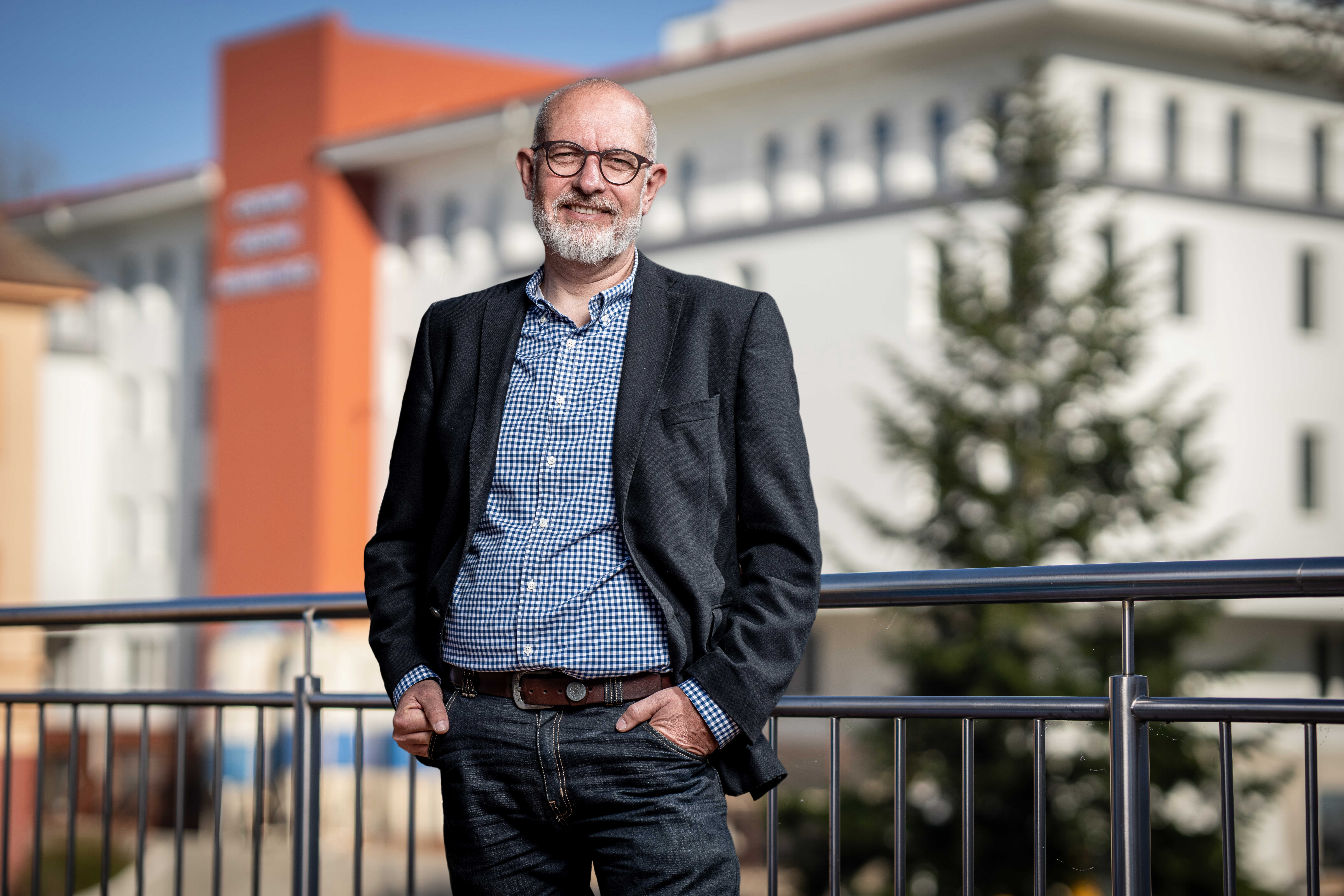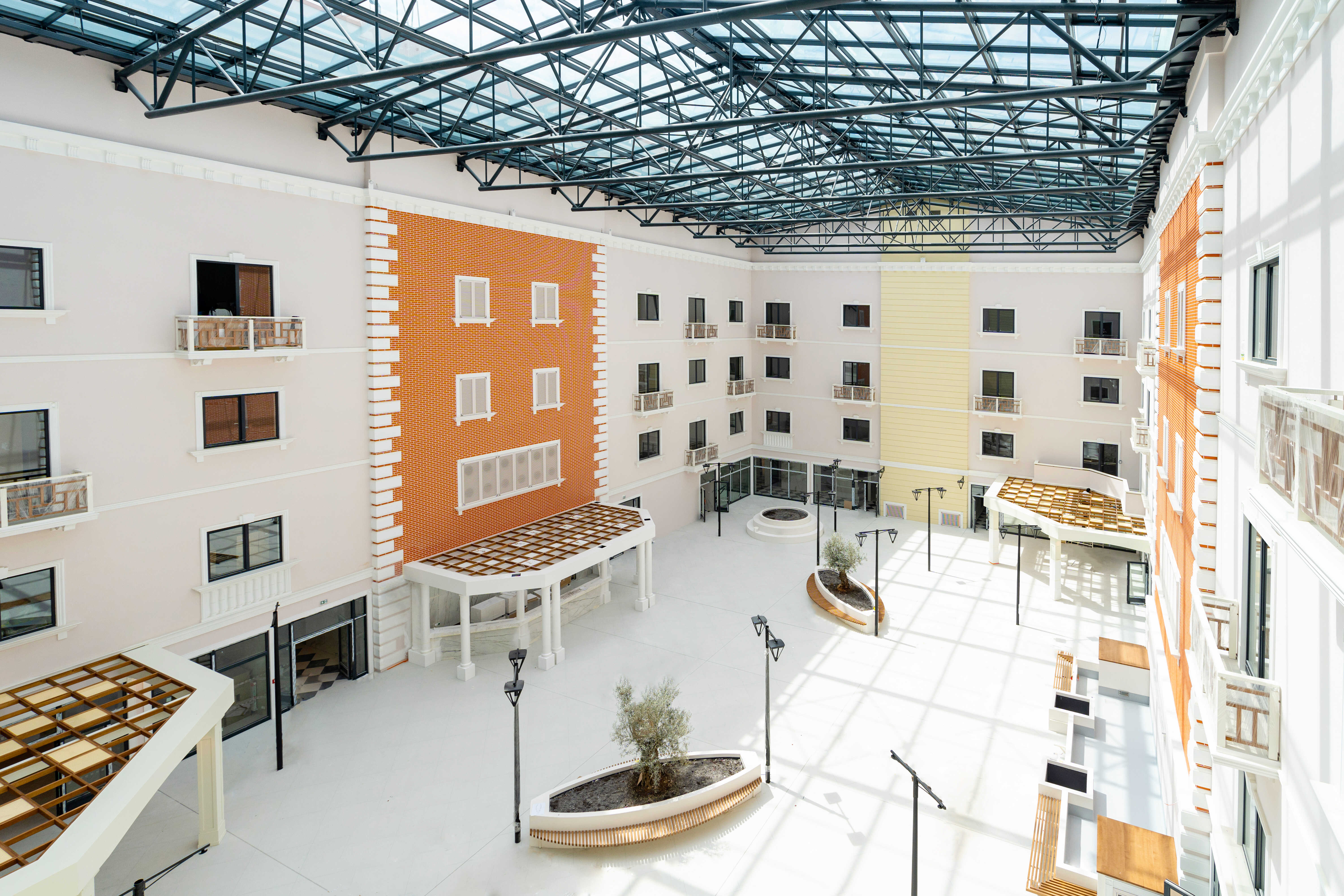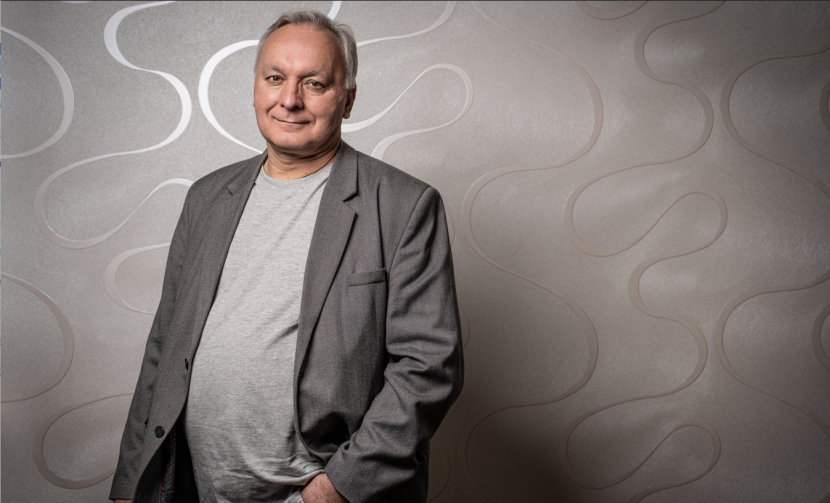You officially launched the centre in June. How is it going - have you already got your first patients, or what kind of patients - outpatients, inpatients?
We have inpatients. We had two smaller fortnightly groups to test the environment and ourselves. It's a smart building, so we need to test what it brings. We all need to fit in because we're in a new environment and the team is new too, with some of them not knowing each other at all. We're working on creating a working atmosphere that people will be comfortable with.
What's the status at the moment?
We have 16 patients on beds. We plan to open the inpatient unit in the autumn. In September we recruited 45 new colleagues who have learned operational things and now need to align in philosophy on how to look at and understand patients. So we are doing groups together to get everyone to befriend each other, and we are also showing each other how to work with patients. Because people come from different departments, and although many of them have experience in psychiatry, there are also general nurses with no experience, and the trainers who focus on physical exercise usually have no experience. So they need to know what illnesses they are going to encounter, how to treat them and know what is going on so they can respond kindly. It is also necessary to bring the team together, because good relationships will translate into good relationships with patients. All of these things carry over.
What about the plan for the coming year, how will you be opening up the different operations?
It depends on the people we recruit. We will be opening one ward on 25 September, with another to follow in late October or early November. If everything goes well, the whole centre could be open within a year.
How many employees will you need in total?
Just over 200, we have about 70 now.
MH: Two hundred is the minimum we can run the centre with, but the ideal is 350 people. We have to factor in the fact that we're talking about the number of full-time jobs, so realistically we're talking about more people. With the current staffing situation and the area of top professionals we are looking for, these are often part-time positions. Towards the function of the whole team, it is actually an advantage to have more people, the fungibility works and the sharing of expertise. On the other hand, if we look at it from an operational point of view, every part-time job is somehow problematic in terms of putting the relationships in the team together and maintaining continuity of care.
Is there any expertise that you are looking for urgently?
We are currently offering positions to psychiatrists, clinical psychologists and of course nurses.
MH: Clinical psychologist in particular is a position we would very much like to fill soon.

In healthcare in general, and in psychiatry this is multiply true, qualified personnel are not easy to find. Where and how do you recruit staff?
Different ways. We talk about it at conferences, with the media, advertise on the website. It's a combination of different avenues. What we've never done is directly solicit someone from somewhere - we don't think that's fair to other workplaces. So we tend to focus more on general advertising and people come from different places.
LL: We certainly don't stand in front of other hospitals and steal their staff away. It's about letting people know about our services, our unique building, and the superior care we give our employees. Most often from our current employees who refer them to our HR department. So information runs through the ether and that's one of the ways we reach new employees.
JP: It's important that we don't poach other departments because we want to work with them. If we antagonize them, it won't be good.
MH: The professor and I are in a bit of a difficult situation because we've both served on bodies that deal with systemic solutions for decades. So we realize that maintaining the system is a bigger priority than our overall good interest.
What do the employees who come to you hear about most?
It's certainly the environment, which is unprecedented not only in our country, but in Europe as a whole. The opportunities here are very much beyond what they had before. We also meet with people long before they come here to establish teamwork and reduce hierarchical tendencies. That's an approach they haven't experienced before - they're usually met with rigidity, whereas we try to work in a community, together. It's not easy because people have some habits - they were used to being told what to do, they just do it and don't do anything extra. We want them to be representative of each other and have good relationships. If we hierarchised the position, there would be fear, and we don't want that. What we want patients to experience, we need among staff. So, as well as the building itself, we attract them to this approach. Above all, we want a good atmosphere and a pleasant way of working with both patients and colleagues. Another non-negligible item is company benefits.
LL: We have an extensive benefits system. I dare say there are few hospitals that offer such a wide list of benefits for both employees with and without families. We recognize that this support for our employees is also important and appreciated.
"What we want patients to experience, we need among our staff."
How do you handle it when someone comes in from a more remote part of the country? AKESO has also built apartments for its employees...
LL: We offer accommodation in our flats, and if we run out of capacity, we search and help find suitable housing in the immediate area in cooperation with real estate agencies. As far as transport is concerned, we have carsharing cars that take employees from Zličín to the hospital on the dates they need.
What problems do you encounter most when starting up? For example, have you found that some things don't work as you imagined and you have to look for other solutions?
We always find some obstacles along the way. When you start something, there are obstacles even in a beautiful building like this. Some of the things that we planned ideally, we have to put together differently. But it's certainly not something that's going to stop us. We're doing things as a team, not with anyone calling the shots.
What do you do most often?
One area is the operation of the computer system. Then it's employee satisfaction, where maybe some people want extra benefits and tensions start to build up in the team, which we have to reconcile. And also, according to the patients who come to us, how best to implement the opening of another department and for whom. We had some ideal idea, but in reality it's different, so we're working on tailoring the program to fit the reality of the patients. It's just dozens of things.
MH: The specific things have a lot to do with ventilation, which is designed throughout the building, and if we only have part of it open, that's been a problem. That's typically a barrier that we have to communicate and devote energy to. We've had to say in community discussion with patients that it doesn't work perfectly, but again, it's gotten us to a partnership level. Through crises, we take relationships, even therapeutic ones, a step further. We are doing something that is not very common in the Czech health care system, where we tell patients that they are the experts on how they feel, i.e., how they are breathing air, even though the sensors say otherwise. Similarly, we deal with shielding, glass transparency and all these things related to fine-tuning technical parameters. In the final analysis, an obstacle can be beneficial and effective.
LL: When it's done well, the feedback from patients who leave is very positive - even if they've experienced some discomfort.
JP: For example, we've had days when the air conditioning wasn't working and we were all sweating with the patients, but they took it very well. They knew it wasn't something that happened on purpose, and the system simply needed a tune-up.

You mentioned the patient mix. What was the original idea and what does it look like in practice now? Are these planned stays, or do ambulances bring patients in?
Super-acute care is not yet staffed, that's yet to come. We now have patients from our outpatient clinic, where they have been examined by a doctor and referred for admission. We take patients across a wide spectrum. The original idea was to divide them by circuits, so for example we will have a ward where patients will be in an acute state, then a finishing ward where they will continue in a different regime and a richer programme, and also a psychotherapy ward which will be partly reserved for a certain circuit not treated in the country, such as obsessive-compulsive or borderline patients. At the moment, however, it seems that we are recruiting all these types of patients to the ward and we cannot split them up because we do not yet have the staff to do so. We originally thought we would have split groups so that care could be targeted straight away, but now we need to have more general care in something. We have patients with different diagnoses who need care, so we can't build a special program for them. But the moment other wards open, we will plan and concretize it that way.
Are individual therapies such as light therapy, virtual reality and so on already in use?
We can't do virtual reality yet, because we need one or two staff to do that. We anticipate that it will be operational by the end of this year or early next year because a dedicated psychiatrist will be coming on board. At the moment we have enough people that we can keep the ward running nicely, with art therapy or the gym already running. So a number of things are already running, but not all of them. We do use phototherapy partly, but that will start to come into play in October or November when patients are more affected.
MH: There's full-spectrum lighting throughout the building. Just the fact that patients are here means they are under the influence of a therapeutic circadian rhythm. We then use a special phototherapy room for indicated patients. As far as virtual reality therapy is concerned, this is one of the areas where we are getting on board the world development train. If we were to buy something that is already in commercial use, we would be going backwards a bit. We want to use it for research and development as well. So, in part, virtual reality therapy will be current as of the end of the year, but only in a limited part - we want to primarily focus on it in research.
What research programs are you planning here?
It's a whole range of things. We want to develop virtual reality programs with a focus on more complex patients with obsessive-compulsive disorder (OCD) or schizophrenia. We also want to develop a programme around light therapy, where we want to investigate how lighting in the centre affects all patients, how this relates to insomnia, attention during the day or fatigue. And then there will be patients who will go to the snail, which is a special room with phototherapy, where they will receive therapy with different intensities. Importantly, we will also be looking at pathways for diagnoses where there are not sufficient treatment programs, such as OCD. We want to develop these more comprehensively and further than is currently being done in the world. For borderline patients, there are four programmes in the world that are working somehow, but they need to be developed further to be more effective. There is also the area of repetitive transcranial magnetic stimulation, where we want to look at what is actually happening in the brain as a person improves - we will be looking at that with EEG imaging. At the same time, we want to look at how effective the therapy programmes really are. Patients are constantly being evaluated and evaluating themselves as well. In the first two runs they have improved a lot in a relatively short time, but it is a mixed group in the overall program. In short, there are a lot of programs.
At the opening of the center, you gave a talk on virtual reality, where you gave an overview of how this therapy is used, particularly in the treatment of phobias. But what might it look like for other problems?
For phobias, we're going to develop what's being done in the world, maybe tweak it a little bit. But further development is needed especially in the area of schizophrenia. One creates an avatar in virtual reality that experiences things and interactions, so the patient learns how to react through this externalised character. Maybe he goes to the store, talks to someone, or gets into an argument. These things are in development and need to continue to be addressed. There's also a lot of room for obsessive-compulsive disorder. Virtual reality so far is mainly focused on being sensitive to getting dirty with something. So they learn to go into a dirty room or somewhere with blood. But there are a number of other compulsions that are not treated at all. These are relational things, for example, where the patient is constantly questioning the other and reassuring themselves, or there are people with aggressive obsessions. They think they're going to kill their child, for example, even though they would never do it, but all their life they have that thought coming back.
Can you give us an idea of what a virtual reality program like this might look like?
Just like in regular therapy. When I have a person who is afraid of stabbing someone, I put a knife in his hand and tell him to put it to my heart, my throat, my eye... He finds out that he is just afraid of it, rather than actually doing it, and after we do it a few times, he eventually stops being afraid of it - he finds out that he doesn't want to hurt anyone. But there aren't that many therapists who want to do it that way; after all, I've been at it for over forty years. But the same thing could be done in virtual reality, where one would have a knife in one's hand, which would be applied to various places on a character's body. Gradually, he will stop being afraid of the idea that he might hurt someone.
"Ideas are visitors, we can invite them and treat them, or we can say, I don't want you - when I think this, it harms me."
You developed the Mindwell program, how many patients are using it today?
During the development period, about 160 people entered the program and we are fine-tuning the program on them. About half drop out because the programme is based on the person having to do something themselves. It's not just about reading something, but there are exercises. Of course, half drop out in the whole world, people just don't want to do the tasks. But those who have completed the program have improved fantastically - almost more than in regular therapy, even. Of course, it's also because it's half. We are now working on making exercise even more appealing, but there will always be a part that won't do it.
Can you give an idea of what the exercises look like?
One is in a situation and has to describe one's thoughts. For example: I burned my lunch, and now I'm thinking I'm an incompetent mother, I can't handle anything, my husband is going to leave me. She writes down her emotions - that she's sad, she's sorry, she's angry with herself... She picks one thing, like "I'm an incompetent mother", and looks for facts that prove she's incompetent - sometimes she burns something, shouts at the children. But then she looks for facts against it - the kids love me, I'm involved with them, I'm learning with them. In the end, she evaluates which is more true. Sometimes I don't do something right, I forget, but I love my children and I am a good mother to them. They also think about how to do it next time. If I burn a meal, I won't make a big deal out of it and do something simpler to get the kids to eat. That's how restructuring happens. But one has to write things down, find the situation and learn the principle of how to discuss with oneself. Sometimes one feels that he is thinking. But that is not true. Thoughts are like visitors; we can invite them and treat them, or we can say, I don't want you - when I think this, it is harmful to me. So one learns to work with thoughts to perceive reality more objectively.
The programme contains a series of animations where, for example, an otter or a bear experiences a situation, their minds are spinning and they solve it somehow. Often in animals you see it more clearly and you think, well, that otter, that's like me. There's hidden humour in it, but it's serious stuff that's somehow repressed. We just try to make it funny, but it hits the basics and it teaches. The hardest thing is to make it appealing - it can't be too complicated, but if it's too simple, it doesn't help. We have to find a balance.
What are the plans for the future?
We have three programmes now and we're about to launch a fourth. We're refining those, we're doing a mobile app. And then we're going to have more failures and problems, but first we want to iron out what we have. Getting it into the program is the hardest part. We come up with the content pretty quickly because we know what therapy looks like. But then we need to work it out so that it's user-friendly, the icons are easy to understand. We have to test these IT things to make the program both effective and user-friendly.
Are the patients who use the program still being monitored remotely?
Each patient has a therapist who gives them feedback. This is important because otherwise most would quit early. The feedback supports them and shows them how they can do things differently, or if they don't understand something, they explain it to them. We have about forty people who do this regularly. In addition, the therapists are supervised by two supervisors, so there is feedback and they improve as well.
Do you have enough people supervising patients in the program, or will you be expanding?
We will expand. Right now, the programming is the most expensive, and the animations are also expensive, and of course we have to pay the therapists as well. So the cost is not small, but in the end it should be much cheaper than regular therapy. But at the beginning you have to invest. Then the advantage is that the patients don't have to travel anywhere, they do it when they have time. And the amazing thing is that when the patient finishes the program, his feeling is: I helped myself. If he goes to therapy, the therapist has helped him. If I help myself, it's a different concept - it's more empowering than if someone else helped me.
For the centre to work systemically, collaboration with other entities is essential. Is it getting off the ground, for example, are the CDR facilities already being used for meetings?
It's going well. We are in contact with all the psychiatric institutions, outpatient psychiatrists and inpatient psychiatric hospitals, we invite them and hold conferences with them. It is important that we keep in touch and network throughout the area.
It has already shown in the care of the first patients, are the outpatient psychiatrists willing to come here to see them, or do you get feedback from them after discharge?
Just today there was an organisation called Lomikámen from Beroun, with whom we arranged joint visits and so on. It's in the early days, but the intention is that we have joint discussions on individual cases. And when a patient ends up with us and needs sheltered housing, we can work with them.
So what shouldn't happen here, which happens quite often in the Czech system, is that the patient drops out.
It should work that way, and so far it has. It's about communication and long-term partnership.
LL: Even when the CDR was being built, we were inviting organisations to come and see what it was like, getting to know each other and creating communication channels so that we knew about each other. That's the foundation.
What was the biggest challenge for you personally during the CDR building project?
To build something that goes beyond conventional practices and takes psychiatry further. To make a good environment and good programs so that people feel that it helps them. When you walk into old facilities, there is already some staff there that you can do something with, but partly not. We have an opportunity here to build it new, which is very nice. That's the biggest thing: we build from scratch, we can discuss it and finish it.
Source: Zdravotnický deník, Michaela Koubová, 25.9.2023














